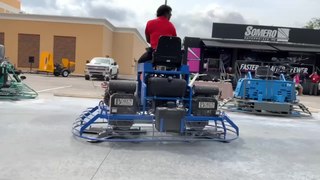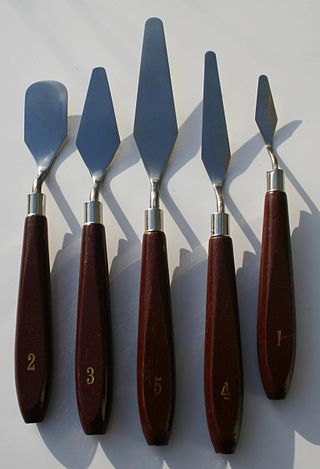
A knife is a tool or weapon with a cutting edge or blade, usually attached to a handle or hilt. One of the earliest tools used by humanity, knives appeared at least 2.5 million years ago, as evidenced by the Oldowan tools. Originally made of wood, bone, and stone, over the centuries, in step with improvements in both metallurgy and manufacturing, knife blades have been made from copper, bronze, iron, steel, ceramic, and titanium. Most modern knives have either fixed or folding blades; blade patterns and styles vary by maker and country of origin.
Flooring is the general term for a permanent covering of a floor, or for the work of installing such a floor covering. Floor covering is a term to generically describe any finish material applied over a floor structure to provide a walking surface. Both terms are used interchangeably but floor covering refers more to loose-laid materials.

Stonemasonry or stonecraft is the creation of buildings, structures, and sculpture using stone as the primary material. Stonemasonry is the craft of shaping and arranging stones, often together with mortar and even the ancient lime mortar, to wall or cover formed structures.

Grout is a dense fluid that hardens used to fill gaps or as reinforcement in existing structures. Grout is generally a mixture of water, cement, and sand, and is employed in pressure grouting, embedding rebar in masonry walls, connecting sections of precast concrete, filling voids, and sealing joints such as those between tiles. Common uses for grout in the household include filling in tiles of shower floors and kitchen tiles. It is often color tinted when it has to be kept visible and sometimes includes fine gravel when being used to fill large spaces. Unlike other structural pastes such as plaster or joint compound, correctly mixed and applied grout forms a water-resistant seal.

A kunai is a Japanese tool thought to be originally derived from the masonry trowel. The two widely recognized kinds are the short kunai and the big kunai. Although a basic tool, the kunai, in the hands of a martial arts expert, could be used as a multi-functional weapon. The kunai is commonly associated with the ninja, who in folklore use them to climb walls.
This page is a list of construction topics.

A kitchen knife is any knife that is intended to be used in food preparation. While much of this work can be accomplished with a few general-purpose knives – notably a large chef's knife, a tough cleaver, a small paring knife and some sort of serrated blade – there are also many specialized knives that are designed for specific tasks. Kitchen knives can be made from several different materials.

Plasterwork is construction or ornamentation done with plaster, such as a layer of plaster on an interior or exterior wall structure, or plaster decorative moldings on ceilings or walls. This is also sometimes called pargeting. The process of creating plasterwork, called plastering or rendering, has been used in building construction for centuries. For the art history of three-dimensional plaster, see stucco.
Canada's Worst Handyman 1 was the first-ever season of the Canadian reality TV show Canada's Worst Handyman, which aired on the Discovery Channel, based on the UK Channel 4 Television Corporation's Britain's Worst Driver. The show is considered to be a sister show of Canada's Worst Driver, as Canada's Worst Handyman shares much of its production crew with Canada's Worst Driver. As with subsequent years, five people, nominated by their family or friends, enter the Handyman Rehabilitation Centre to improve their handyman skills, in an effort to not be named Canada's Worst Handyman. This year, the Handyman Rehabilitation Centre is located in a public housing complex building in the Regent Park neighborhood of Toronto that has since been demolished to make way for a FreshCo supermarket and new apartments.

A taping knife or joint knife is a drywall tool with a wide blade for spreading joint compound, also known as "mud". It can be used to spread mud over nail and screw indents in new drywall applications and is also used when using paper or fiberglass drywall tape to cover seams. Other common uses include patching holes, smoothing wall-coverings and creating specialty artistic wall finishes. Common sizes range from 15cm to 30cm wide. Spackle knives are a smaller version, used for patching small holes.

Tuckpointing is a way of using two contrasting colours of mortar in the mortar joints of brickwork, with one colour matching the bricks themselves to give an artificial impression that very fine joints have been made. In some parts of the United States and Canada, some confusion may result as the term is often used interchangeably with pointing and repointing.

The Masonry trowel is a hand trowel used in brickwork or stonework for levelling, spreading and shaping mortar or concrete. They come in several shapes and sizes depending on the task. The following is a list of the more common masonry trowels:
A hori-hori, sometimes referred to as a "soil knife" or a "weeding knife", is a heavy serrated multi-purpose steel blade for gardening jobs such as digging or cutting. The blade is sharp on both sides and comes to a semi-sharp point at the end.

A solid ground floor consists of a layer of concrete, which in the case of a domestic building will be the surface layer brought up to ground floor level with hardcore filling under it.

In masonry, mortar joints are the spaces between bricks, concrete blocks, or glass blocks, that are filled with mortar or grout. If the surface of the masonry remains unplastered, the joints contribute significantly to the appearance of the masonry. Mortar joints can be made in a series of different fashions, but the most common ones are raked, grapevine, extruded, concave, V, struck, flush, weathered and beaded.

Marshalltown Company is a privately held American manufacturer of construction tools and equipment used for archaeology, asphalt, concrete, drywall, EIFS, flooring, masonry, painting, plastering, stucco, tile, and wallpaper based in Marshalltown, Iowa. Marshalltown, founded in 1890, was one of the top producers of construction tools and equipment in the world, including the Marshalltown pointing trowel, a tool often used by American archaeologists.

A power trowel is a piece of light construction equipment used by construction companies and contractors to apply a smooth finish to concrete slabs.

An oscillating multi-tool or oscillating saw is a multitool and power tool that oscillates, powered by battery or mains. The name "multi-tool" is a reference to the many functions that this tool can perform with the range of attachments available. "Master Tool" is also a trade name used in North America, short for the original tool by Fein called the Multi-Master. Attachments are available for sawing, sanding, rasping, grinding, scraping, cutting, and polishing.

A painting knife is an artist's tool with a flexible steel blade used to apply and manipulate paint directly on the canvas. They are manufactured in a variety of styles and sizes. Blades can be long and thin, triangular, rectangular or diamond shaped. Handles are either straight or offset like a trowel.


















